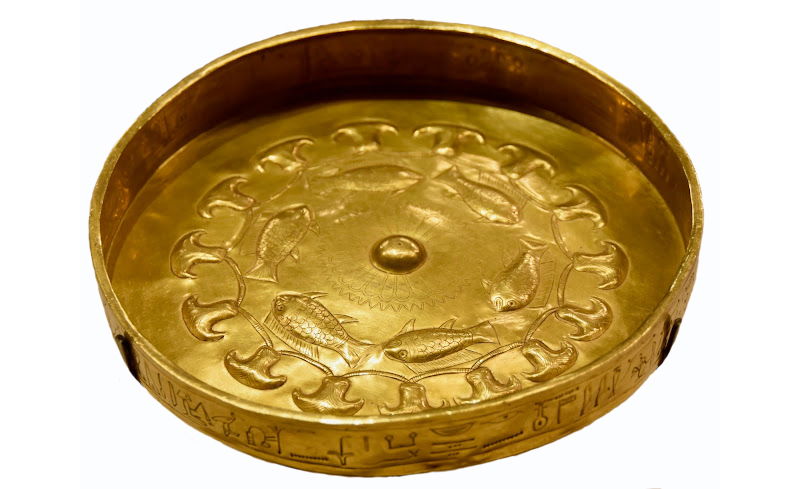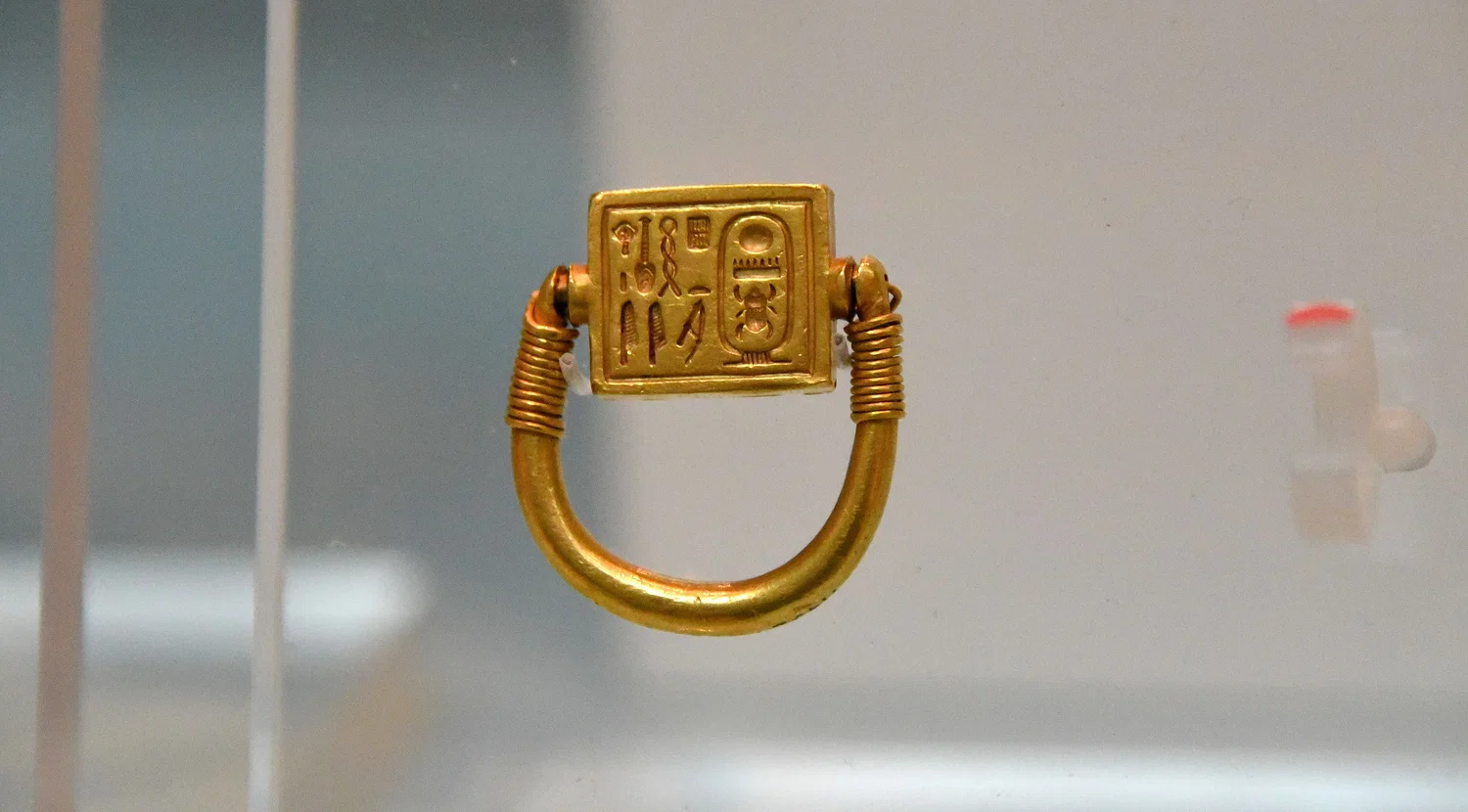ΧΡΥΣΗ ΦΙΑΛΗ & ΛΟΙΠΑ ΑΝΑΘΗΜΑΤΑ ΤΟΥ ΣΤΡΑΤΗΓΟΥ Djehuty: ΕΛΛΑΔΙΚΕΣ ΣΥΣΧΕΤΙΣΕΙΣ, Η ΑΛΩΣΗ ΤΗΣ ΤΡΟΙΑΣ κ.α. ~ 1500 π.Χ.
Πάπυρος Harris 500[1]
"Η κατάληψη της Ιόππης" είναι μια αρχαία αιγυπτιακή ημιμυθική ιστορία που περιγράφει την κατάκτηση της Συρο – Παλαιστινιακής πόλεως Yapu (Ιόππη - Joppa, σύγχρονη Χάιφα / Τελ Αβίβ) από τον Djehuty, στρατηγό του Thutmose III (1504-1450 π.Χ.). Το σωζόμενο αντίγραφο του κειμένου περιλαμβάνεται στον Papyrus Harris 500, αυτή δε η ιστορία θεωρείται παραδοσιακά ως μια καθαρώς λογοτεχνική αφήγηση της κατακτήσεως η οποία έλαβε χώραν στον απόηχο της εκστρατείας του Thutmose III στην Συρία. Υπήρχε, ωστόσο, ένας διοικητής στρατευμάτων ονόματι Djehuty που υπηρετούσε υπό τον Thutmose III. Οι τακτικές που χρησιμοποίησε ο Djehuty στην ιστορία, όταν κατέλαβε την εχθρική Ιόππη κρύβοντας τους στρατιώτες του σε μεγάλα καλάθια - φόρο τιμής στον άρχοντα,[2] συχνά αναφέρεται ότι θυμίζουν το επεισόδιο του Οδυσσεακού Δούρειου ίππου και στην ιστορία του "Ali Baba and the Forty Thieves" από τις Αραβικές Νύκτες! Ωστόσο, φαίνεται ότι αυτή η ιστορία προϋπήρχε του λογοτεχνικού σκηνικού της ελληνικής παραδόσεως κατά περισσότερο από 200 χρόνια.[4]
Χειρόγραφη μινιατούρα του Δούρειου ίππου στο χειρόγραφο Vergilius Romanus στην Αινειάδα του Βιργίλιου, 5ος αι.[6]
Σημειώνεται ότι στο έδαφος του συγχρόνου Ισραήλ είναι η Ιόππη - Χάιφα το μοναδικό σημείο όπου διαδραματίζεται Ελληνικός μύθος, αυτός του Περσέως και της Ανδρομέδας![8] Πράγματι η θέση ευρίσκετο στην καρδιά της Φιλισταϊκής περιοχής, όπου είχε εγκατασταθεί αυτό το Αιγαιακής προελεύσεως φύλο κατά τις μετακινήσεις των Λαών της Θάλασσας λίγο μετά το 1200 π.Χ. Από την Μυκηναϊκή περίοδο η ομώνυμη αγγειοπλαστική υπήρξε στην περιοχή ιδαίτερα δημοφιλής,[10] όπως και η Κυπριακή και Αιγυπτιακή.[12] H πληθώρα εισαγόμενων μυκηναϊκών, κυπριακών και αιγυπτιακών εμπορευμάτων υποδηλώνουν τον ρόλο του λιμανιού σε αυτό το εμπόριο κατά τη διάρκεια αυτής της περιόδου. Πράγματι, το λιμάνι πιθανότατα λειτουργούσε και ως στρατηγικό σημείο ανεφοδιασμού για τις αιγυπτιακές δυνάμεις που εκστρατεύουν στο νότιο Λεβάντε.
Ο στρατηγός Djehuty φαίνεται ότι δεν ήταν φανταστικό πρόσωπο. Τον χειμώνα του 1824, ο Bernardino Drovetti βρήκε τον εντελώς ασύλητο τάφο του στη Saqqara. Σε αυτές τις πρώτες μέρες, η αιγυπτιακή αρχαιολογία ήταν στα σπάργανα και μόνο μερικές σημειώσεις από τις ανασκαφές έγιναν τότε. Σήμερα, υπάρχουν μόνο σύντομες περιγραφές των τεκμηρίων, αυτά δε εν συνεχεία πωλήθηκαν σε διάφορες συλλογές μουσείων σε όλο τον κόσμο και, στις περισσότερες περιπτώσεις, μπορούν να αποδοθούν με βεβαιότητα στον τάφο του Djehuty μόνον όταν φέρουν το όνομά του. Τα αντικείμενα που βρέθηκαν στον τάφο του στρατηγού περιλαμβάνουν χρυσή και αργυρά φιάλη, και τα δύο σήμερα στο Λούβρο, τέσσερα κανωπικά αγγεία τώρα στη Φλωρεντία, τον σκαραβαίο της καρδιάς, ένα χρυσό βραχιόλι στο Rijksmuseum του Leiden[13] και το ξιφίδιο του Djehuty στο Darmstadt. Τίποτα δεν είναι γνωστό για το φέρετρο και την μούμια του Djehuty, αν και αναφέρθηκαν εν συντομία από τον Drovetti.[14]
Χρυσή φιάλη του Djehuty (Louvre)[15]
Αργυρά φιάλη του Djehuty (Louvre)[18]
Ενιαφέρον είναι σχετικώς το σχόλιο της Lilyquist αναφορικά με το τεκμήριο Louvre E 4886:[19]
.. Εφ' όσον αποδεχτούμε ότι πρόκειται μάλλον γιά φιάλη και όχι πινάκιο, τότε μπορούμε να αποκαλέσουμε ομφαλό το κεντρικό κομβίο, χαρακτηριστικό το οποίο είναι νέο στα Αιγυπτιακά αγγεία της περιόδου.[19_84] Μάλιστα τάφος από το Lower Assasif περιείχε φιάλη με ομφαλό καθώς και όπλο νέο στην Αίγυπτο,[19_85] οπότε η πιθανότητα της ξένης προελεύσεως μπορεί επίσης να εξεταστεί για την φιάλη και αυτού του τάφου.[19_86] Τέτοιες φιάλες αναπαρίστανται σ ε ιδιωτικό τάφο στις Θήβες της εποχής του Tuthmosis IV.[19_87]
Μάλιστα η ίδια ερευνήτρια διαπιστώνει ότι υπάρχει μια εντυπωσιακή ομοιότητα μεταξύ του ρόδακα της αργυράς φιάλης και του αντίστοιχου θέματος που διακοσμεί την βάση ανάλογων τεχνουργημάτων του Θησαυρού Tod,[19_103] καθώς και μεσομινωικά ζωγραφισμένα αγγεία,[19_104] και αγγεία του ρυθμού Yahudiyeh;[19_105]
Πιστεύεται επίσης ότι το δαχτυλίδι Ashburnham, το οποίο είναι "ένα από τα πιο εντυπωσιακά τεχνουργήματα αιγυπτιακής κοσμηματοποιίας που προστίθενται στην εθνική συλλογή [του Βρετανικού Μουσείου] εδώ και πολλά χρόνια", προήλθε επίσης από την ταφή του στρατηγού Djehuty.
Παρακάτω μάλιστα η ίδια ερευνήτρια θεωρεί: .. είναι ότι τα φυτικά στοιχεία που συνδέονται σε ένα μοτίβο εμφανίζονται έξω από την Αίγυπτο νωρίτερα από την εποχή του Τούθμωσης ΙΙΙ, δηλαδή στη μεσομινωική κεραμική,[19_124] σε μια εντύπωση σφραγίδας από το επίπεδο VII στο Alalakh,[19_125] και στην φαγεντιανή Kerma.[19_126] Οι φυτικές αλυσίδες εμφανίζονται σε μια κυλινδρική σφραγίδα από το Ras Shamra,[19_127] και σε κεραμική Yahudiyeh από τη Βύβλο[19_128] και την Κύπρο.[19_129]
Εν ολίγοις, το ασημένιο κύπελλο θα ήταν το παλαιότερο διακοσμημένο μεταλλικό σκεύος που ήταν γνωστό μέχρι σήμερα από την Αίγυπτο
Πιστεύεται επίσης ότι το δαχτυλίδι Ashburnham, το οποίο είναι "ένα από τα πιο εντυπωσιακά τεχνουργήματα αιγυπτιακής κοσμηματοποιίας που προστίθενται στην εθνική συλλογή [του Βρετανικού Μουσείου] εδώ και πολλά χρόνια", προήλθε επίσης από την ταφή του στρατηγού Djehuty.
Ωοκέλυφο πολύχρωμο αγγείο της περιόδου MM IIa (Evans 1921, pl. 2A, Κνωσός).
Δαχτυλίδι Ashburnham
Μεσο - Μινωικά αγγεία τύπου Καμαρών και πώμα φαγεντιανής από την Κέρμα[26]
Άλλωστε ενδεικτικές των σχέσεων μεταξύ του Αιγαίου και της Αιγύπτου είναι οι απεικονίσεις απεσταλμένων προς την χώρα του Νείλου από το αρχιπέλαγος, οι οποίοι απεοκονίζονται φέροντες δώρα! Ο Uroš Matić σημειώνει σχετικά:[30]
Οι διπλωματικές σχέσεις μεταξύ της αιγυπτιακής αυλής της 18ης δυναστείας και των πολιτειών της Εποχής του Χαλκού στο Αιγαίο κερδίζουν ολοένα και μεγαλύτερη προσοχή. Η εργασία που έχει γίνει μέχρι τώρα για τον χρονολογικό συγχρονισμό έχει δημιουργήσει μια σχετικά σταθερή βάση για περαιτέρω συζητήσεις σχετικά με τις κοινωνικές σχέσεις. Ο ρόλος των αντικειμένων κύρους που φτάνουν από το Αιγαίο στην Αίγυπτο δεν έχει λάβει την ίδια προσοχή. Αυτό οφείλεται εν μέρει στο ότι οι γνώσεις μας για αυτά τα αντικείμενα περιορίζονται στις αιγυπτιακές οπτικές αναπαραστάσεις στους τάφους των αξιωματούχων και όχι στα εισαγόμενα αντικείμενα καθαυτά. Αυτή η εργασία θα συζητήσει τις μεταμορφωτικές ικανότητες της αιγυπτιακής κοσμιότητας σε σχέση με τα ξένα αντικείμενα κύρους Αιγαιακής προελεύσεως που φτάνουν στα Αιγυπτιακά ανάκτορα της 18ης δυναστείας. Πρώτα πρέπει να κατανοήσουμε τα εικονογραφικά φαινόμενα μεταφοράς, υβριδισμού και δημιουργικότητας στον Αιγυπτιακό εικαστικό πολιτισμό και μόνο τότε μπορούμε να προσπαθήσουμε να διαβάσουμε οποιαδήποτε ιστορική πραγματικότητα πίσω από αυτά. Αυτές οι μεταμορφωτικές αναπαραστατικές διαδικασίες είναι καθοριστικές για την κατανόηση της πρόσληψης και της μνήμης των αντικειμένων του Αιγαίου.
Ο ίδιος ερευνητής σημειώνει:[32]
Είναι ενδιαφέρον ότι ξεκινώντας από τον τάφο του Useramun που χρονολογείται στην πρώιμη βασιλεία του Thutmose III, όπου πρωτοεμφανίζονται τα ρυτά με κεφάλι γρύπα, οι ζωγράφοι άρχισαν να απεικονίζουν τις μορφές των απεσταλμένων του Αιγαίου με σπείρες (μπούκλες) στο μέτωπό τους (Εικ. 3 & 5) και στην κορυφή του κεφαλιού τους στους μεταγενέστερους τάφους.
"ο έμπιστος του βασιλιά σε όλες τις ξένες χώρες και τα νησιά που βρίσκονται στην μέση του Ouadj -Our".
Η τελευταία τοπωνυμική έκφραση είναι πανομοιότυπη με αυτή των υπομνημάτων των σκηνών
που απεικονίζουν την προσφορά δώρων από Αιγαίους απεσταλμένους, και κοσμούν τον δυτικό τοίχο της βόρειας πτέρυγας των Θηβαϊκών τάφων των ανώτερων αξιωμούχων Useramon (TT 131) και Rekhmire (TT 100), που βρίσκονται στο Sheikh Abd el-Gournah. Σύμφωνα και με τον Jean Vercoutter (1956), συμφωνούμε τώρα να αποδεχθούμε την ισοδυναμία μεταξύ των 'νησιών που βρίσκονται στη μέση της Μεγάλης Πράσινης Θάλασσας' και του Αιγαιοπελαγίτικου κόσμου![34]
ΣΗΜΕΙΩΣΕΙΣ
[1]. Papyrus, Museum number EA10060 <https://www.britishmuseum.org/collection/object/Y_EA10060>
[2]. Kelder 2022. Ο ερευνητής γράφει: Εκτός από τις ικανότητές του με το τόξο, το διάσημο τέχνασμά του με τον Δούρειο ίππο μοιάζει εντυπωσιακά με την αιγυπτιακή ιστορία του στρατηγού Djehuty, ο οποίος υπηρετούσε υπό τον Thutmose III και αναφέρεται ότι κατέλαβε την εχθρική πόλη της Ιόππης κρύβοντας τους στρατιώτες του σε μεγάλα καλάθια. προσφέρεται στον άρχοντα της πόλης ως φόρο τιμής.
[4]. Βικιπαίδεια, s.v. Η κατάληψη της Ιόππης: σύγχρονη Yaffa.
[6]. RomanVirgilFolio101r.jpg
[8]. Yudin 2012.
[10]. Guzowska and Yasur-Landau 2005.
[12]. Burke et al. 2017.
[12a]. https://www.christies.com/en/lot/lot-5567196?fbclid=IwAR3G_Yfb_8CVA-fTniPFWciG9xtWWnnHE4sNlw4yLy1D2OoNlC6mjijwjrk
[13]. A gold bracelet inscribed with the prenomen of pharaoh Thutmose III found in General Djehuty's intact tomb. This object belonged to General Djehuty's funerary treasures and is now located in the Rijksmuseum van Oudheden at Leiden in the Netherlands. Djehuty was famous in Ancient Egyptian Egyptian literature for capturing the city of Joppa on Thutmose III's behalf by resorting to subterfuge. The Egyptian hieroglyphic inscription: Ntr-Nfr Mn-kheper-Ra Di-Ankh God-Beautiful-(Wonderful) Men-Kheper-Ra-(Thutmose III) Given-Life (see Talk page)
[14]. Βικιπαίδεια, s.v. Djehuty (general).
[15]. https://www.ifao.egnet.net/uploads/images/une/zoom/Coupe_N%20713.jpg
[15]. https://www.ifao.egnet.net/uploads/images/une/zoom/Coupe_N%20713.jpg
[18]. Furutani 2017, fig. 2. Photo of Louvre E 4886 <https://collections.louvre.fr/en/ark:/53355/cl010008672?fbclid=IwAR2EXQseP3n2fNbY5pTs3eN9hWfZSeVAo4iHvraolQKynHGZx1xKIMqizzs>.
[19]. Lilyquist 1988, p. 17, nn. 84-87.
[19-84]. Lilyquist 1988, n. 84. Ανάλογα τεχνουργήματα προέρχονται από την Εγγύς Ανατολή και το Αιγαίο.
[19-85]. Lilyquist 1988, n. 85. Οπιθανώς Αιγαιακή η καταγωγή του τεχνουργήματος!
[19-86]. Lilyquist 1988, n. 86.
[19-87]. Lilyquist 1988, n. 87.
[19-88]. Lilyquist 1988, n. 88.
[19_103]. Lilyquist 1988, p. 19, n. 103. Για την Αιγαιακή συσχέτιση του θησαυρού βλ. Κονιδάρη (Κονιδάρης 2022, άρθρο 12.3, σελ. 193 κ.ε.).
[19_104]. Lilyquist 1988, p. 19, n. 104. Βλ. το αγγείο τύπου 'κέλυφος αυγού' παραπάνω!
[19_105]. Lilyquist 1988, p. 19, nn. 105.
[19_125]. Lilyquist 1988, p. 20, n. 125.
[19_126]. Lilyquist 1988, p. 20, n. 126.
[19_127]. Lilyquist 1988, p. 20, n. 127.
[19_128]. Lilyquist 1988, p. 20, n. 128.
[19_129]. Lilyquist 1988, p. 20, n. 129.
[22]. Lilyquist 1998, p. 5.
[26]. Stevenson Smith 1965, fig. 20b.
[30]. Uroš Matić 2019.
[32]. Uroš Matić 2019, p. 658.
[34]. Dautais 2022.
ΒΙΒΛΙΟΓΡΑΦΙΑ
Kelder, J. M. 2022. "From Thutmose III to Homer to Blackadder: Egypt, the Aegean, and the 'Barbarian Periphery' of the Late Bronze Age World System,"in Egypt and the Classical World: Cross-Cultural Encounters in Antiquity, <https://www.getty.edu/publications/egypt-classical-world/01/> (11 March 2023).
https://metmuseum.academia.edu/christinelilyquist
https://www.metmuseum.org/art/metpublications/the_gold_bowl_naming_general_djehuty_the_metropolitan_museum_journal_v_23_1988
Lilyquist, C. 1988. "The Gold Bowl Naming General Djehuty: A Study of Objects and Early Egyptology," Metropolitan Museum Journal 23, pp. 5-68.
https://www.jpost.com/travel/around-israel/off-the-beaten-track-perseus-must-die
Joe Yudin. 2012. "Off the Beaten Track: Perseus must die," Jerusalem Post, <https://www.jpost.com/travel/around-israel/off-the-beaten-track-perseus-must-die> (11 March 2023).
Guzowska, M. and A. Yasur-Landau. 2005. "Along the Yarkon River: Trade and Consumption of Mycenaean Pottery from Jaffa to Aphek," in EMPORIA: Aegaeans in Central and Eastern Mediterranean (10th International Aegaean Conference, Aegaeum 25)”, ed. R. Laffineur and E. Greco.
https://www.ancientportsantiques.com/wp-content/uploads/Documents/PLACES/Levant/Jaffa-Burke2017.pdf?fbclid=IwAR23yGmCKIZvXnlahjOZStvewZtSuoos5dl3x10JIeI6bUFEIHAzf_yTYik
Burke, A., S. Wachsmann, S. Avnaim - Katav, R. K. Dunn, K. Kowalski, G. A. Pierce, and M. Peilstöcker. 2017. "Jaffa’s ancient inland harbor: historical, cartogr aphic, and geomorphological data," in The History and Archaeology of Jaffa (Monumenta Archaeologica 41), ed. A. A . Burke, K. Strange Burke, and M. Peilstöcke, Los Angeles, pp. 89-112.
Furutani, J. K. 2017. "Miscellaneous Historical Aspects of the Taking of Joppa Together with An Edition and Grammatical Commentary on Both The Taking of Joppa and Louvre N713, NMC 1210.
https://archive.org/details/smithinterconnec0000unse/page/212/mode/2up?view=theater
Stevenson Smith, W. 1965. "Interconnections in the Ancient NearEast, New Haven. fig. 20b. https://archive.org/.../smithinterco.../page/212/mode/2up...
Κονιδάρης, Δ. Ν. 2022. Ο πρώιμος Αιγυπτιακός πολιτισμός και οι αλληλεπιδράσεις με το Αιγαίο (β' έκδ.), Αθήνα.
https://www.researchgate.net/publication/333580296_Memories_into_Images_Aegean_and_Aegean-like_Objects_in_New_Kingdom_Egyptian_Theban_Tombs
Uroš Matić. 2019. "Memories into Images: Aegean and Aegean-like Objects in New Kingdom Egyptian Theban Tombs," Cambridge Archaeological Journal 29(4), pp. 1-17.
https://www.academia.edu/77474820/Coupe_en_or_du_g%C3%A9n%C3%A9ral_Dj%C3%A9houty
Dautais, L. 2022. "Coupe en or du général Djéhouty," in IFAO - Rubrique "Une image, un commentaire", 24 avril 2022, https://www.ifao.egnet.net/image/78. Some thoughts on General Djehuty, his role and the materiality of the Egypto-Aegean interactions during the 15th c. BCE: a brief note to read (in French) on the Institut français d’archéologie orientale - IFAO website.
ΠΛΕΟΝ ΠΡΟΣΦΑΤΟΣ ΕΜΠΛΟΥΤΙΣΜΟΣ - ΕΠΙΜΕΛΕΙΑ: 060623
https://www.researchgate.net/publication/396375644_CHRYSE_PHIALE_LOIPA_ANATHEMATA_TOU_STRATEGOU_Djehuty_ELLADIKES_SYSCHETISEIS_E_ALOSE_TES_TROIAS_ka_1500_pCH











